TOYOTA MATRIX 2010 E140 / 2.G Owner's Guide
Manufacturer: TOYOTA, Model Year: 2010, Model line: MATRIX, Model: TOYOTA MATRIX 2010 E140 / 2.GPages: 448, PDF Size: 9.74 MB
Page 31 of 448
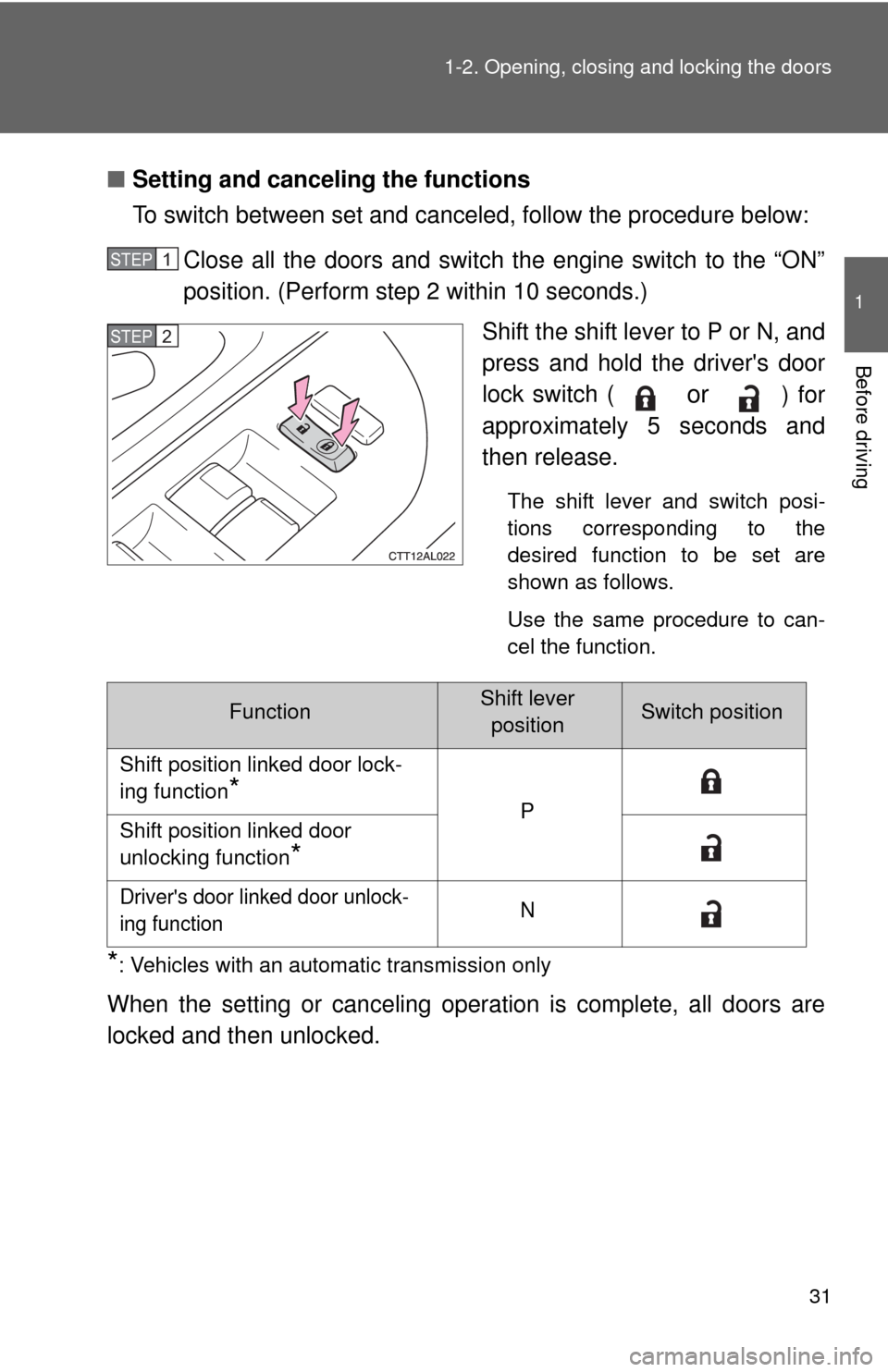
31 1-2. Opening, closing and locking the doors
1
Before driving
■Setting and canceling the functions
To switch between set and canceled, follow the procedure below:
Close all the doors and switch the engine switch to the “ON”
position. (Perform step 2 within 10 seconds.)
Shift the shift lever to P or N, and
press and hold the driver's door
lock switch (
or ) for
approximately 5 seconds and
then release.
The shift lever and switch posi-
tions corresponding to the
desired function to be set are
shown as follows.
Use the same procedure to can-
cel the function.
*: Vehicles with an automatic transmission only
When the setting or canceling operation is complete, all doors are
locked and then unlocked.
STEP1
STEP2
FunctionShift lever
positionSwitch position
Shift position linked door lock-
ing function
*P
Shift position linked door
unlocking function
*
Driver's door linked door unlock-
ing functionN
Page 32 of 448
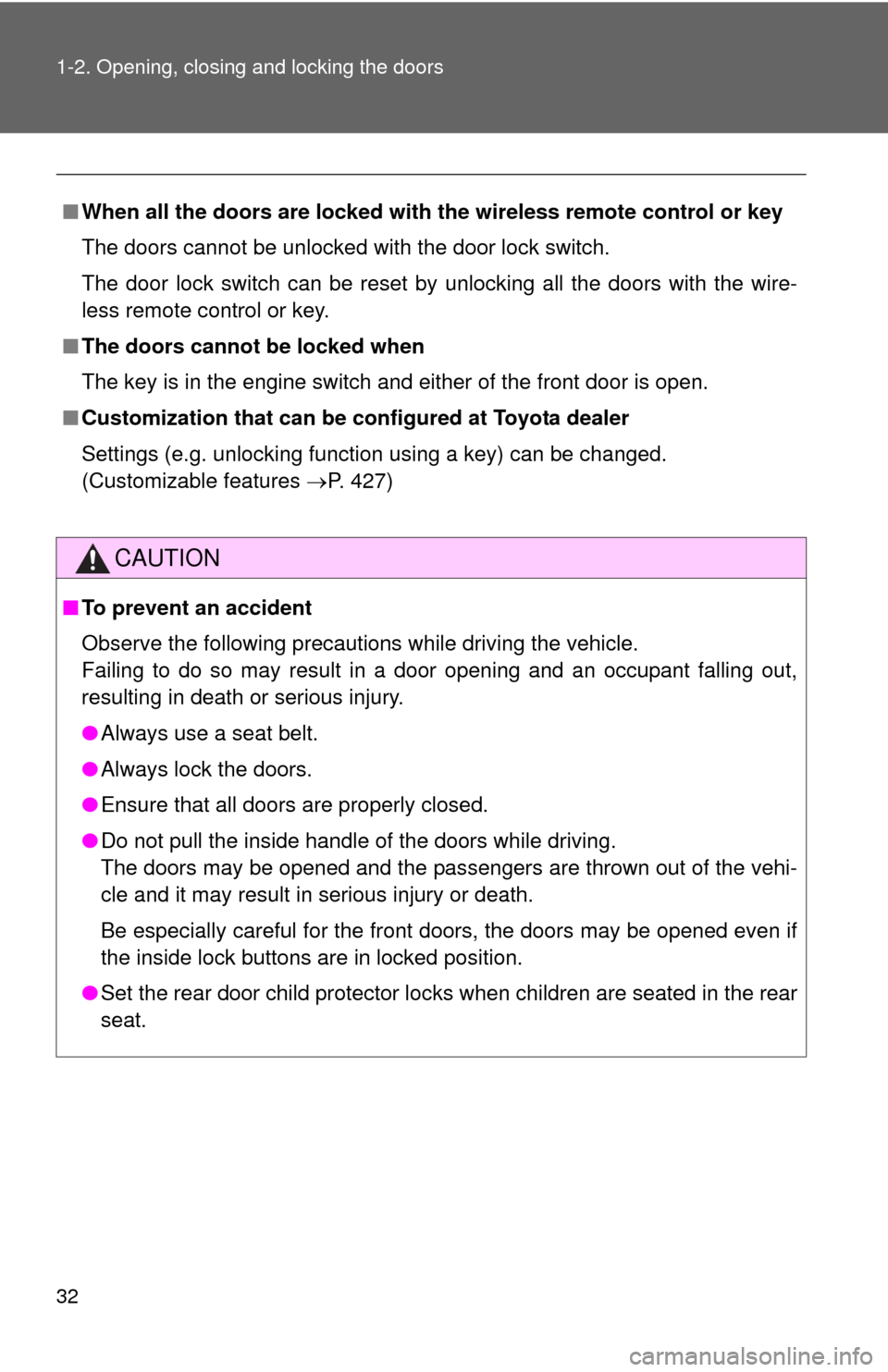
32 1-2. Opening, closing and locking the doors
■When all the doors are locked with the wireless remote control or key
The doors cannot be unlocked with the door lock switch.
The door lock switch can be reset by unlocking all the doors with the wire-
less remote control or key.
■The doors cannot be locked when
The key is in the engine switch and either of the front door is open.
■Customization that can be configured at Toyota dealer
Settings (e.g. unlocking function using a key) can be changed.
(Customizable features P. 427)
CAUTION
■To prevent an accident
Observe the following precautions while driving the vehicle.
Failing to do so may result in a door opening and an occupant falling out,
resulting in death or serious injury.
●Always use a seat belt.
●Always lock the doors.
●Ensure that all doors are properly closed.
●Do not pull the inside handle of the doors while driving.
The doors may be opened and the passengers are thrown out of the vehi-
cle and it may result in serious injury or death.
Be especially careful for the front doors, the doors may be opened even if
the inside lock buttons are in locked position.
●Set the rear door child protector locks when children are seated in the rear
seat.
Page 33 of 448
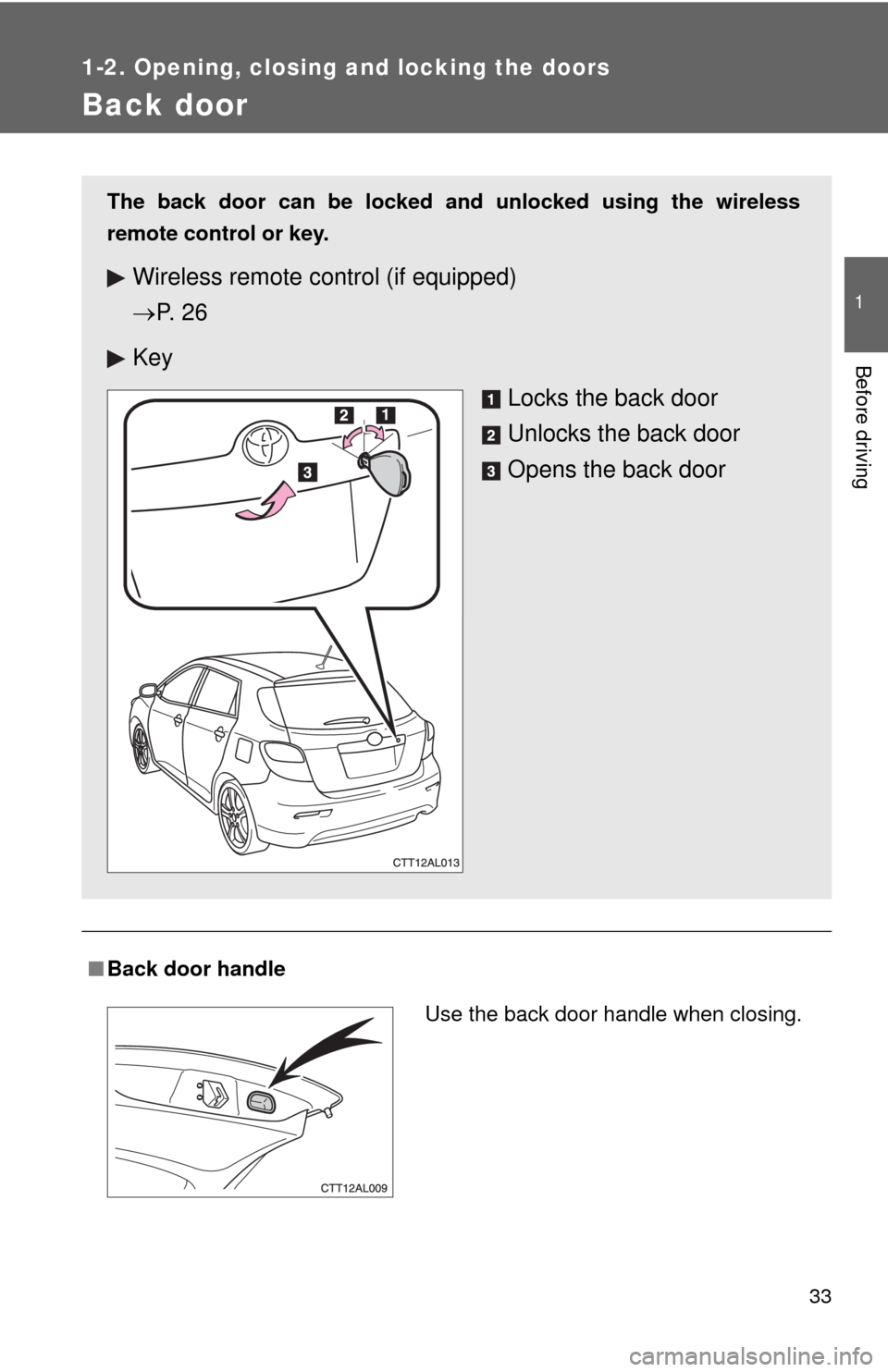
33
1
1-2. Opening, closing and locking the doors
Before driving
Back door
■Back door handle
The back door can be locked and unlocked using the wireless
remote control or key.
Wireless remote control (if equipped)
P. 2 6
Key
Locks the back door
Unlocks the back door
Opens the back door
Use the back door handle when closing.
Page 34 of 448
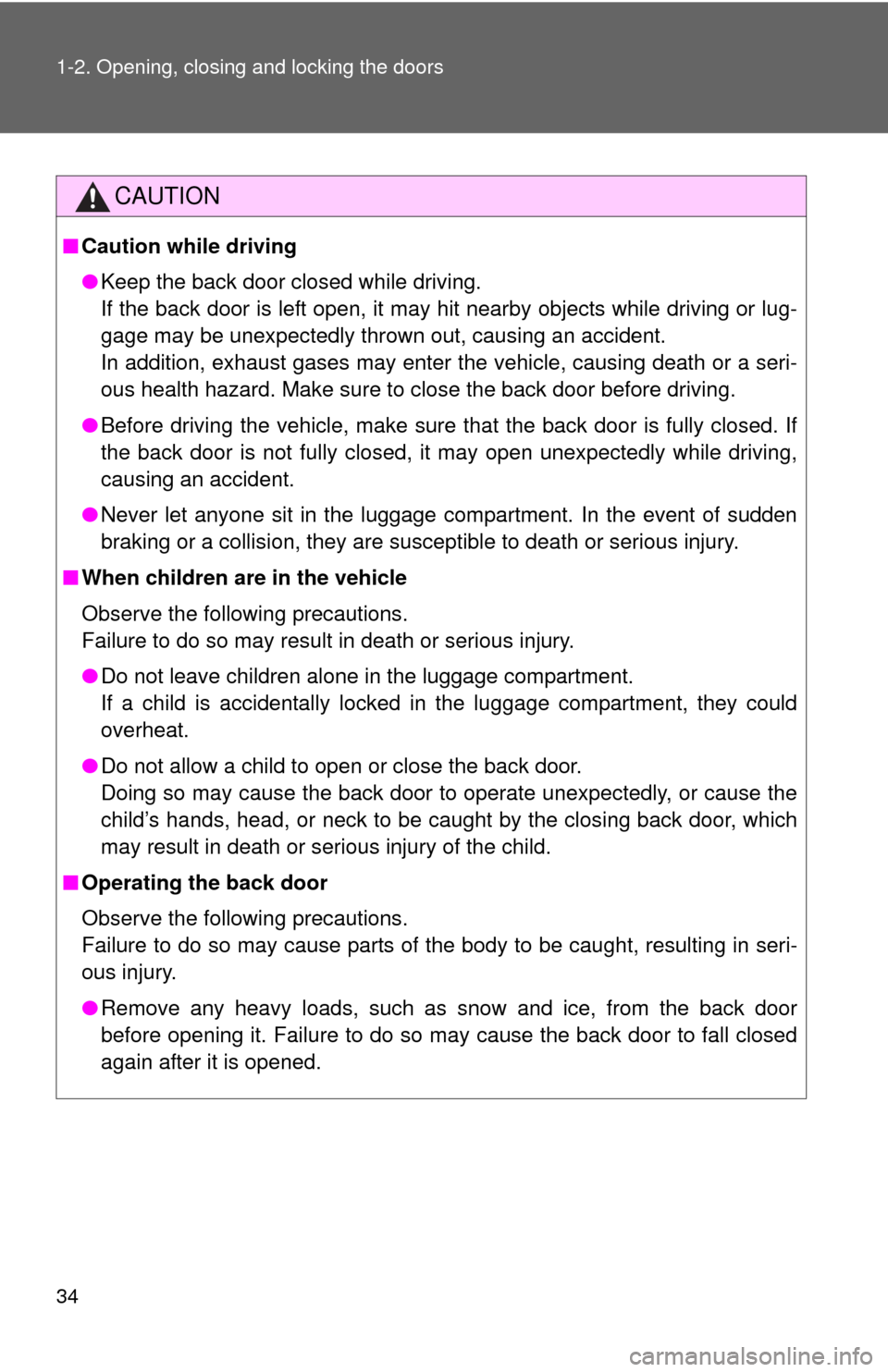
34 1-2. Opening, closing and locking the doors
CAUTION
■Caution while driving
●Keep the back door closed while driving.
If the back door is left open, it may hit nearby objects while driving or lug-
gage may be unexpectedly thrown out, causing an accident.
In addition, exhaust gases may enter the vehicle, causing death or a seri-
ous health hazard. Make sure to close the back door before driving.
●Before driving the vehicle, make sure that the back door is fully closed. If
the back door is not fully closed, it may open unexpectedly while driving,
causing an accident.
●Never let anyone sit in the luggage compartment. In the event of sudden
braking or a collision, they are susceptible to death or serious injury.
■When children are in the vehicle
Observe the following precautions.
Failure to do so may result in death or serious injury.
●Do not leave children alone in the luggage compartment.
If a child is accidentally locked in the luggage compartment, they could
overheat.
●Do not allow a child to open or close the back door.
Doing so may cause the back door to operate unexpectedly, or cause the
child’s hands, head, or neck to be caught by the closing back door, which
may result in death or serious injury of the child.
■Operating the back door
Observe the following precautions.
Failure to do so may cause parts of the body to be caught, resulting in seri-
ous injury.
●Remove any heavy loads, such as snow and ice, from the back door
before opening it. Failure to do so may cause the back door to fall closed
again after it is opened.
Page 35 of 448
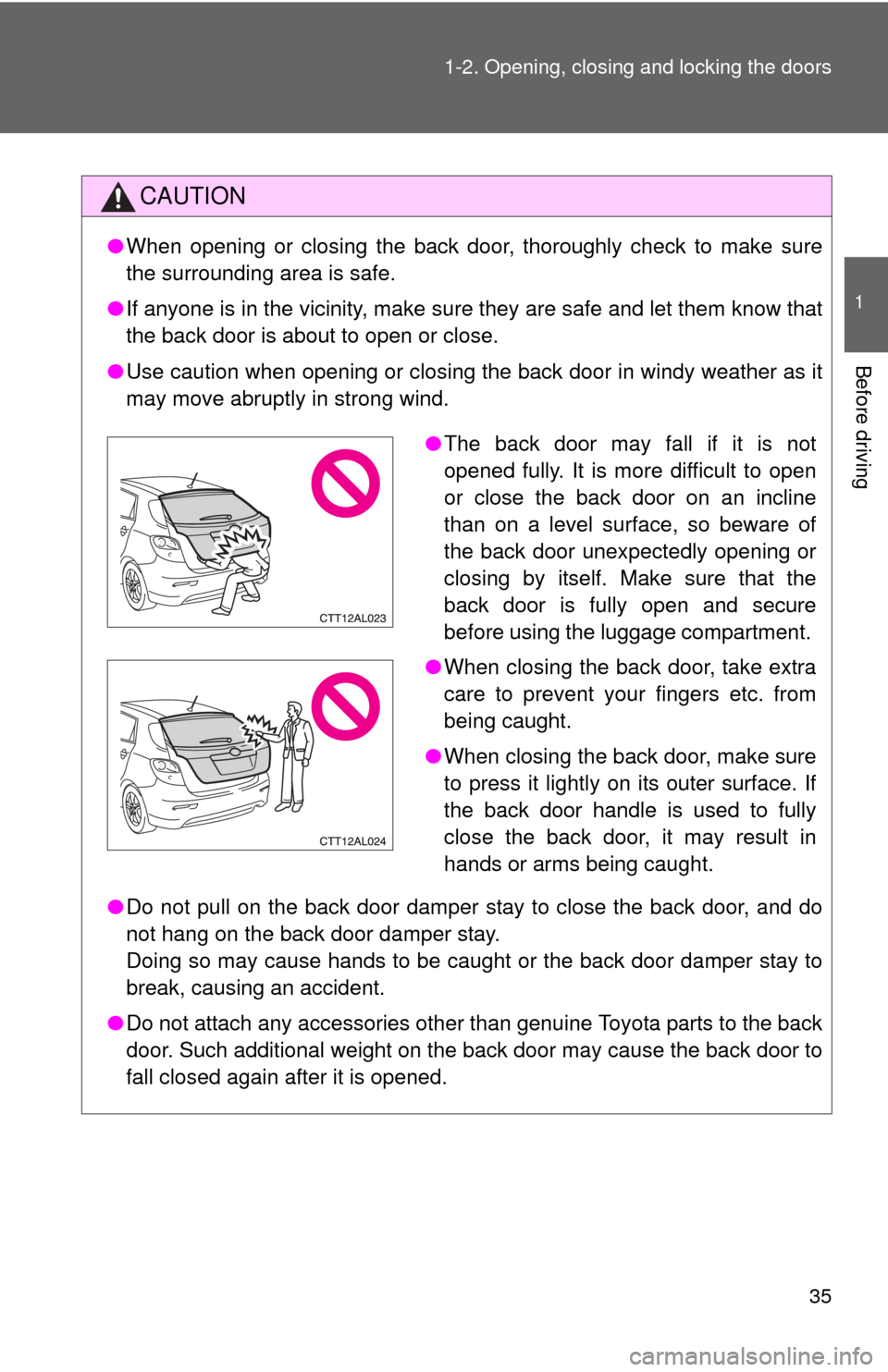
35 1-2. Opening, closing and locking the doors
1
Before driving
CAUTION
●When opening or closing the back door, thoroughly check to make sure
the surrounding area is safe.
●If anyone is in the vicinity, make sure they are safe and let them know that
the back door is about to open or close.
●Use caution when opening or closing the back door in windy weather as it
may move abruptly in strong wind.
●Do not pull on the back door damper stay to close the back door, and do
not hang on the back door damper stay.
Doing so may cause hands to be caught or the back door damper stay to
break, causing an accident.
●Do not attach any accessories other than genuine Toyota parts to the back
door. Such additional weight on the back door may cause the back door to
fall closed again after it is opened.
●The back door may fall if it is not
opened fully. It is more difficult to open
or close the back door on an incline
than on a level surface, so beware of
the back door unexpectedly opening or
closing by itself. Make sure that the
back door is fully open and secure
before using the luggage compartment.
●When closing the back door, take extra
care to prevent your fingers etc. from
being caught.
●When closing the back door, make sure
to press it lightly on its outer surface. If
the back door handle is used to fully
close the back door, it may result in
hands or arms being caught.
Page 36 of 448
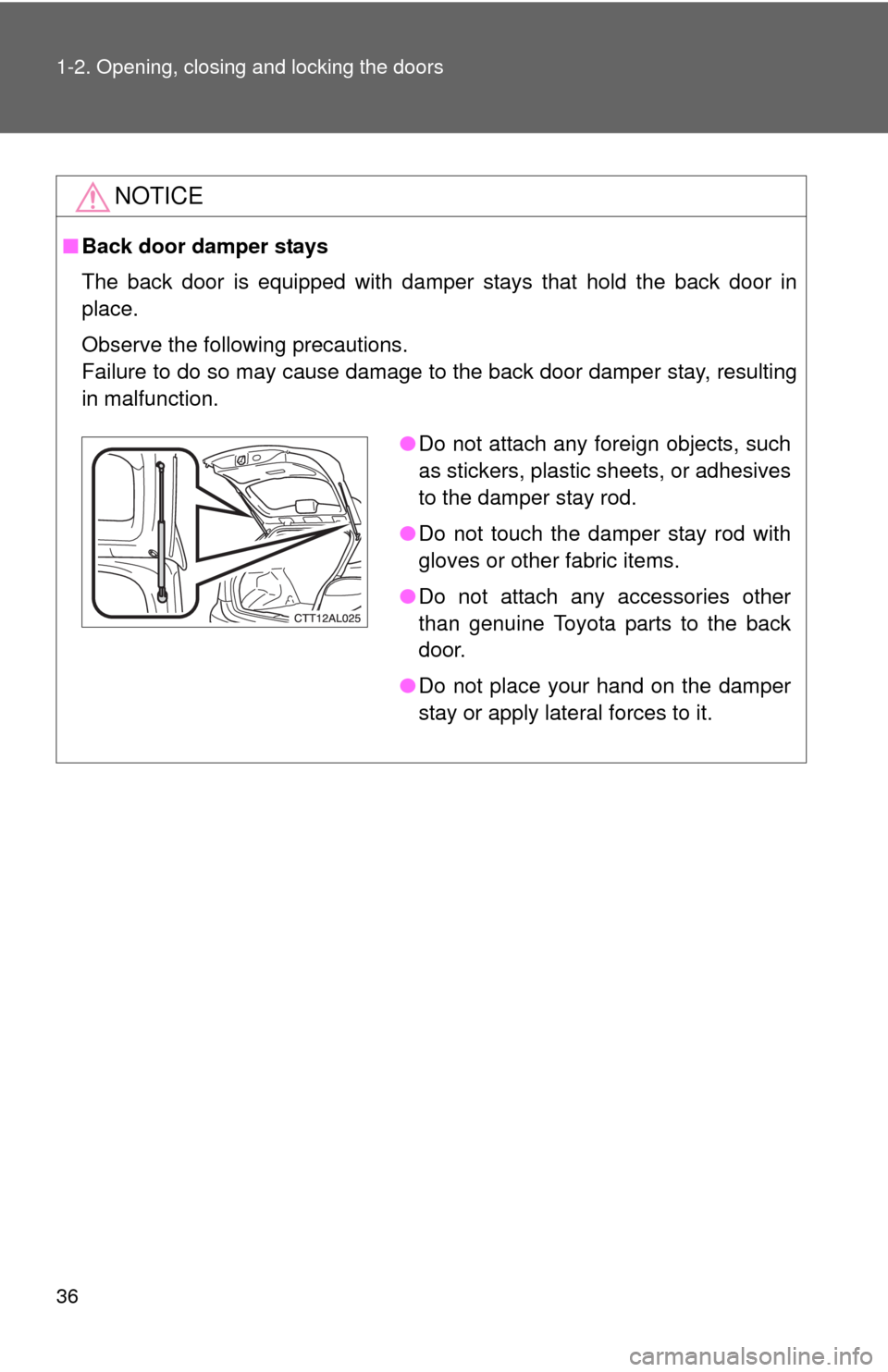
36 1-2. Opening, closing and locking the doors
NOTICE
■Back door damper stays
The back door is equipped with damper stays that hold the back door in
place.
Observe the following precautions.
Failure to do so may cause damage to the back door damper stay, resulting
in malfunction.
●Do not attach any foreign objects, such
as stickers, plastic sheets, or adhesives
to the damper stay rod.
●Do not touch the damper stay rod with
gloves or other fabric items.
●Do not attach any accessories other
than genuine Toyota parts to the back
door.
●Do not place your hand on the damper
stay or apply lateral forces to it.
Page 37 of 448
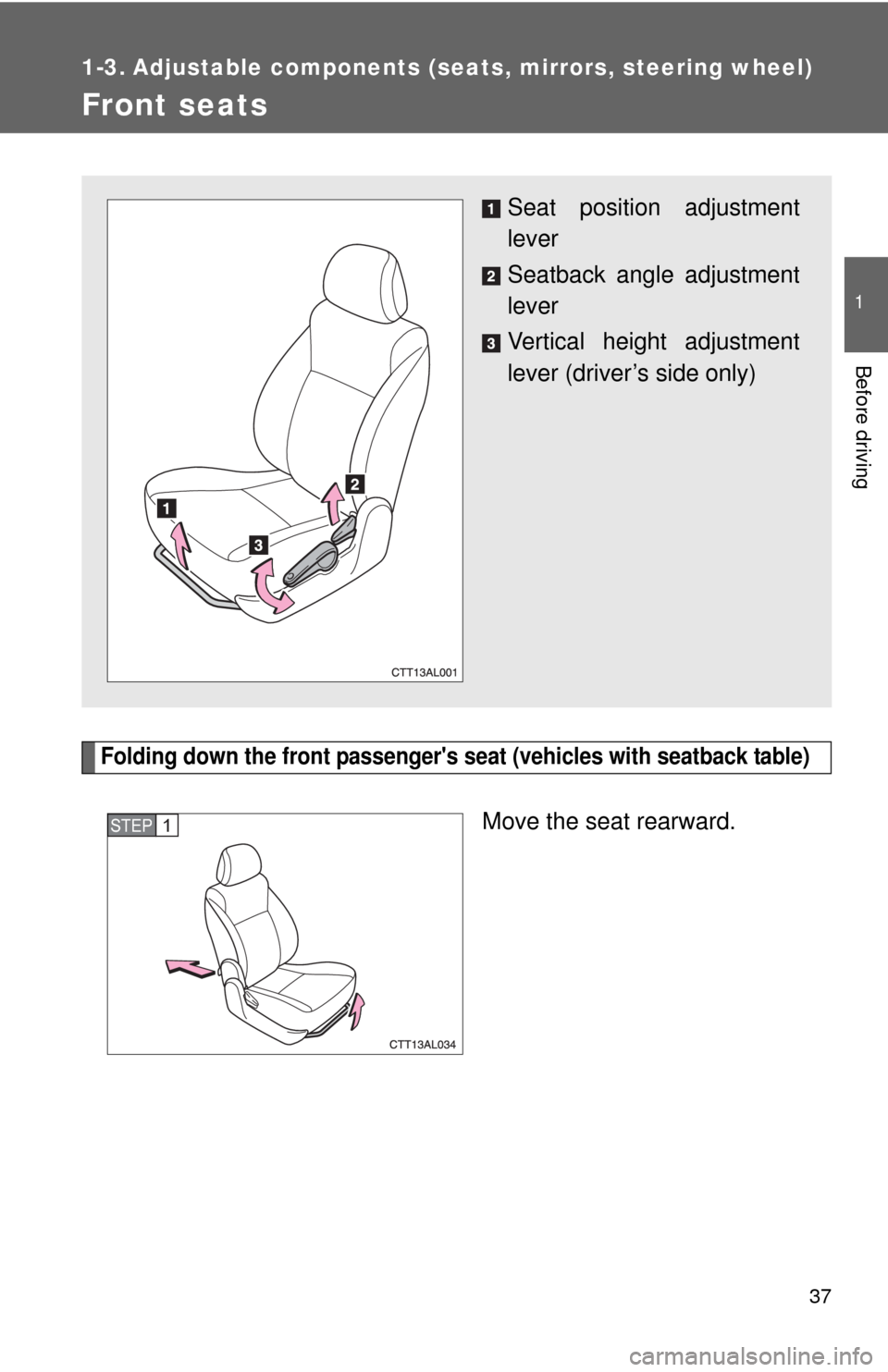
37
1
Before driving
1-3. Adjustable components (seats, mirrors, steering wheel)
Front seats
Folding down the front passenger's seat (vehicles with seatback table)
Move the seat rearward.
Seat position adjustment
lever
Seatback angle adjustment
lever
Vertical height adjustment
lever (driver’s side only)
STEP1
Page 38 of 448
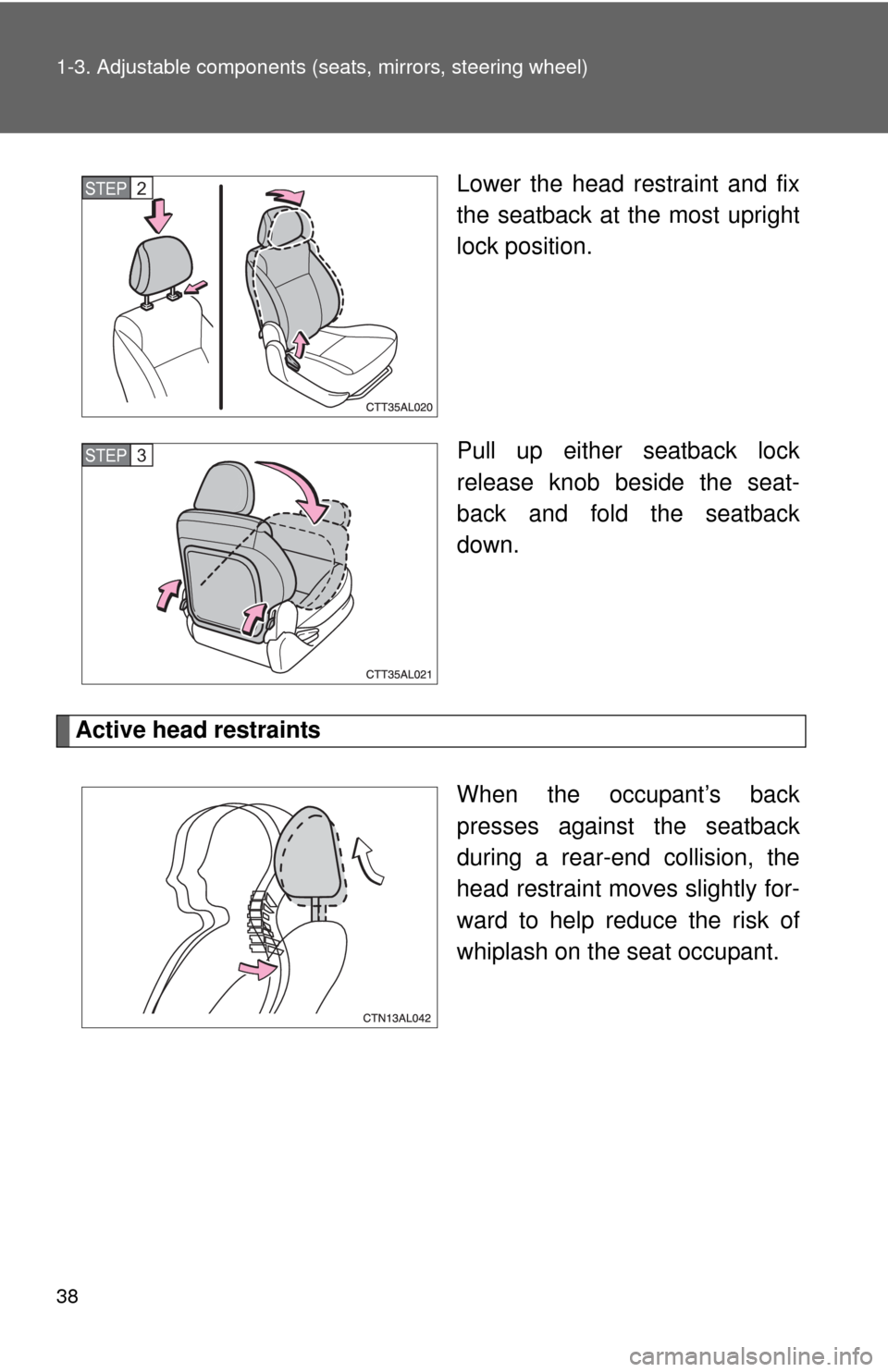
38 1-3. Adjustable components (seats, mirrors, steering wheel)
Lower the head restraint and fix
the seatback at the most upright
lock position.
Pull up either seatback lock
release knob beside the seat-
back and fold the seatback
down.
Active head restraints
When the occupant’s back
presses against the seatback
during a rear-end collision, the
head restraint moves slightly for-
ward to help reduce the risk of
whiplash on the seat occupant.
STEP2
STEP3
Page 39 of 448
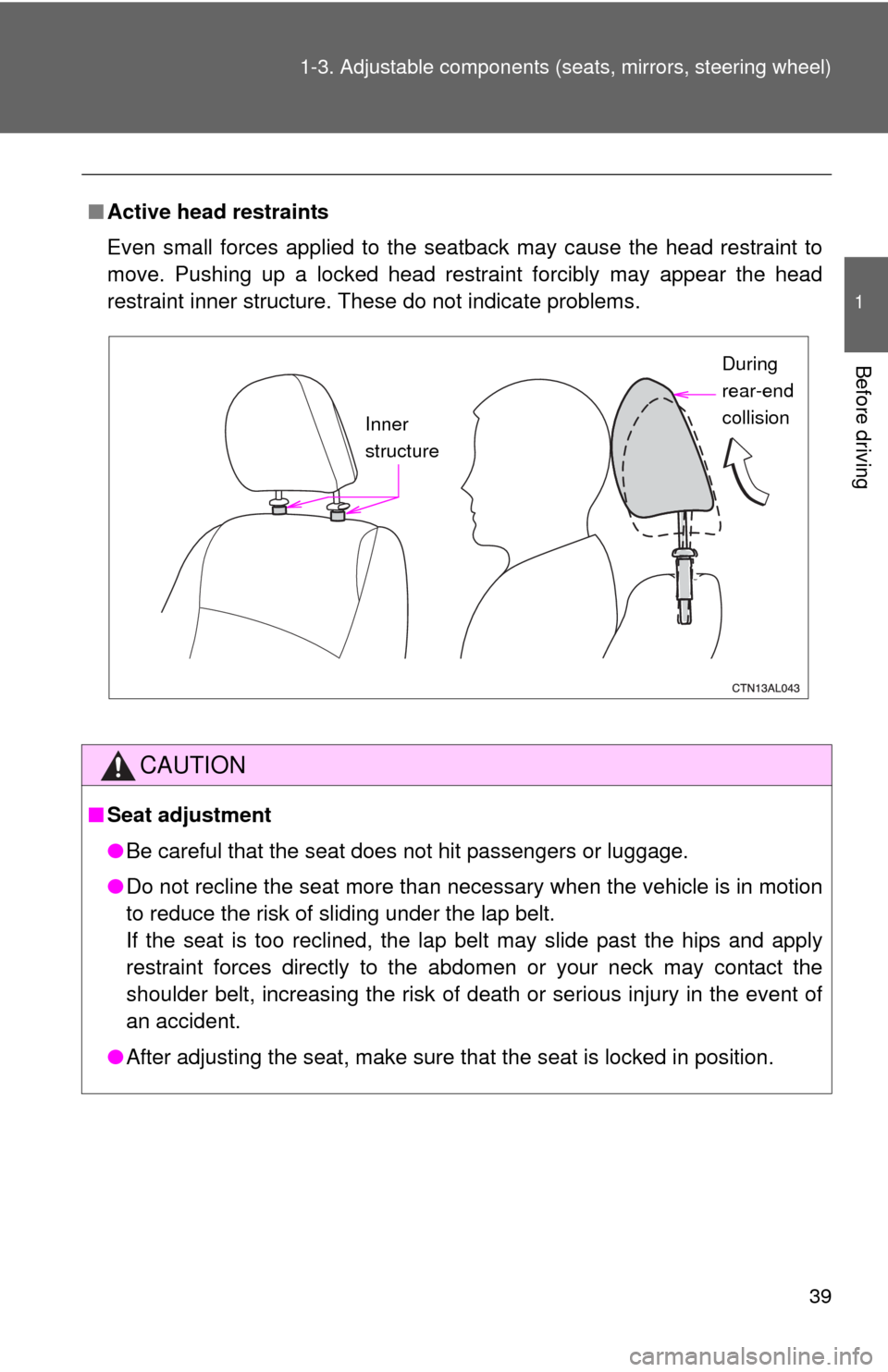
39 1-3. Adjustable components (seats, mirrors, steering wheel)
1
Before driving
■Active head restraints
Even small forces applied to the seatback may cause the head restraint to
move. Pushing up a locked head restraint forcibly may appear the head
restraint inner structure. These do not indicate problems.
CAUTION
■Seat adjustment
●Be careful that the seat does not hit passengers or luggage.
●Do not recline the seat more than necessary when the vehicle is in motion
to reduce the risk of sliding under the lap belt.
If the seat is too reclined, the lap belt may slide past the hips and apply
restraint forces directly to the abdomen or your neck may contact the
shoulder belt, increasing the risk of death or serious injury in the event of
an accident.
●After adjusting the seat, make sure that the seat is locked in position.
Inner
structureDuring
rear-end
collision
Page 40 of 448

40 1-3. Adjustable components (seats, mirrors, steering wheel)
CAUTION
■After returning the seatback to the upright position (vehicles with seat-
back table)
Make sure the seatback is securely locked by pressing forward and rear-
ward on the top of the seatback. Failure to do so will prevent seat belt from
operating properly.
■Caution while driving (vehicles with seatback table)
Do not sit on or place anything on the folded seatback.